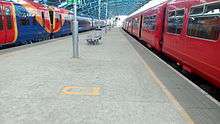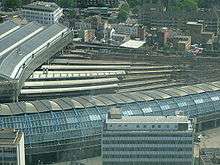Waterloo International railway station
Coordinates: 51°30′11″N 0°06′53″W / 51.502973°N 0.114809°W
| Waterloo International | |
|---|---|
.jpg) Four Eurostar Class 373 at Waterloo International | |
| Location | South Bank |
| Local authority | London Borough of Lambeth |
| Number of platforms | 5 (1 in use) |
| Key dates | |
| 14 November 1994 | Opened |
| 13 November 2007 | Closed |
| 5 August 2017 | Reopened Temporarily |
| 5 September 2017 | Closed for Upgrade Works |
| Replaced by | St Pancras International |
| Other information | |
| Lists of stations | |
|
| |
Waterloo International station was the London terminus of the Eurostar international rail service from its opening on 14 November 1994 until it closed on 13 November 2007 when it was replaced by St Pancras as the terminal for international rail services. It stands on the western side of Waterloo railway station, but was managed and branded separately from the main-line station.
In August 2017, the buildings and platforms were incorporated into the main Waterloo station when the platforms reopened during the works at platforms 1-8. The platforms closed again on 5 September 2017. After a period of redevelopment, they will be permanently re-opened in December 2018 as part of the main station.[1]
History
The station was designed by the architectural firm Grimshaw Architects with Sir Alexander Gibb & Partners (consultant Engineers) and Bovis Construction (as the main contractors).[2] It cost £120 million and was completed in May 1993, in time for the scheduled completion of the Channel Tunnel. Construction of the Tunnel was delayed however, and the station did not open until November 1994, when it won the European Union Prize for Contemporary Architecture as well as the Royal Institute of British Architects' Building of the Year award.[3]
Waterloo International had five platforms, numbered 20 to 24, one (20) taken from the main-line station, and four new ones. Unlike the platforms at the main station, they were long enough to accommodate trains of up to 20 coaches (total length 394 metres). The platforms were all covered by a 400 m long [2] glass and steel vault of 36 arches forming a prismatic structure, conceived by Anthony Hunt Associates. The five vaults are supported by a grid of cylindrical concrete columns that rise up from the carpark level, through the circulation levels to the platforms. A structural glass wall separated the existing Waterloo Station from the International station.[2] A two-level reception area fronted the main station concourse. The curvature of the roof is steeper on the western side and here the trains passed close to the structure. The roof arches are made up of two dissimilar curved trusses, triangular in section, with compression booms of tubular steel (CFS) and tension booms of solid steel. Both compression and tension members are curved — structural engineer Anthony Hunt described the trusses as "banana shaped". Curved, tapering trusses were later used to great effect at Kirklees Stadium in Huddersfield.[2]
The first Eurostar departure, on 14 November 1994, was formed of Eurostar units 373004/373003 [4] and the last service left at 18.12 GMT on 13 November 2007 for Brussels. From the next day Eurostar services used their new London terminus of St Pancras International.[5]
Post Eurostar

Mainline railways around the South Bank | ||||||||||||||||||||||||||||||||||||||||||||||||||||||||||||||||||||||||||||||||||||||||||||||||||||||||||||||||||||||||||||||||||||||||||||||||||||||||||||||||||||||||||||||||||||
|---|---|---|---|---|---|---|---|---|---|---|---|---|---|---|---|---|---|---|---|---|---|---|---|---|---|---|---|---|---|---|---|---|---|---|---|---|---|---|---|---|---|---|---|---|---|---|---|---|---|---|---|---|---|---|---|---|---|---|---|---|---|---|---|---|---|---|---|---|---|---|---|---|---|---|---|---|---|---|---|---|---|---|---|---|---|---|---|---|---|---|---|---|---|---|---|---|---|---|---|---|---|---|---|---|---|---|---|---|---|---|---|---|---|---|---|---|---|---|---|---|---|---|---|---|---|---|---|---|---|---|---|---|---|---|---|---|---|---|---|---|---|---|---|---|---|---|---|---|---|---|---|---|---|---|---|---|---|---|---|---|---|---|---|---|---|---|---|---|---|---|---|---|---|---|---|---|---|---|---|---|
| ||||||||||||||||||||||||||||||||||||||||||||||||||||||||||||||||||||||||||||||||||||||||||||||||||||||||||||||||||||||||||||||||||||||||||||||||||||||||||||||||||||||||||||||||||||
Ownership of Waterloo International station passed to BRB (Residuary) Ltd., with no clear plans for the future use of the Eurostar platforms.[6] Some reports had suggested that they might be used for shops,[7] but a parliamentary written answer of 4 June 2008 stated platform 20 was to be used by some South West Trains services from December 2008.[8] At the time of closure, Network Rail had no immediate plans to use the other four former international platforms for domestic use [9] and they were disused from November 2007.[10]
From 4 July 2010[11] to 2 January 2011[12] two of the disused platforms hosted theatrical performances of E. Nesbit's The Railway Children. The audience was seated either side of the actual railway track. The show includes the use of a steam engine, coupled to one of the original carriages from the 1970 film, being shunted in and out of the theatre area as required by a Class 08 shunter.
All of the international platforms were temporarily used for regional services during the refurbishment of the main station starting in Christmas 2013.[13] Platform 20 came back into regular use for timetabled services in May 2014.[14]
In March 2016, it was reported that the platforms and terminal building will be incorporated into the main station as part of a £800 million refurbishment of Waterloo.[15] In August 2017 the platforms were used temporarily while other platforms were upgraded and then after a further period of closure for redevelopment they will be permanently brought back into use in December 2018.[1] The terminal building will house a new shopping mall.[16]
Design
British Rail developed a series of concepts during the late 1980s with an initial location at the opposite end of the concourse.
A more appropriate location was subsequently defined as at present but at first incorporating an existing staff building alongside Platform 10 while displacing the Armstrong lift that was on the site and had provided the means of allowing Waterloo City Line stock to be raised up from the tunnels below.
Before long, the existing staff building as well as the lift were abandoned but the new terminal was already then taking the form initially of a cable-stayed, flat-roofed structure and was the basis for the final stage of the Hybrid Parliamentary Bill as it passed through the House of Lords and as featured in a press release at the time.
The in-house design team assisted by Sir Alexander Gibb and Partners as traffic Engineers co-opted the services of Anthony Hunt so as to take the dynamic structure forward. However the BR architects felt that a cable stayed structure, while in vogue at the time might not be so innovative come an operational opening then planned for May 1993.
Security issues as well as structural and the above consideration led the designers to review alternative structural forms that might meet the evolving brief. An arch structure had its appeal in that an arch-based tracery was subtly evident at Waterloo over the approach road and was more likely to be fresher than a cable-stayed option by the time the terminal was ready for use in the early to mid 1990s. Arches were not the vogue in the early 1980s.
The form selected was soon to be based on a series of lattice arches of decreasing sizes and each connected with a Teflon membrane. Additional transparency was to be provided by glazing over each of the lattice arches.
The five-track configuration implied each arch grounding alongside the track but creating a challenge in avoiding a potential clash between the kinetic envelope of the anticipated new rolling stock and the "shed" structure.
BR's in-house architects however established this wind-sock form as the basis for briefing external architectural practices competing for the detail design stage that followed.
Also, along the way, the use of Teflon was abandoned in favour of a stainless steel covering.
See also
Gallery
Eurostar | |||||||||||||||||||||||||||||||||||||||||||||||||||||||||||||||||||||||||||||||||||||||||||||||||||||||||||||||||||||||||||||||||||||||||||||||||||||||||||||||||||||||||
|---|---|---|---|---|---|---|---|---|---|---|---|---|---|---|---|---|---|---|---|---|---|---|---|---|---|---|---|---|---|---|---|---|---|---|---|---|---|---|---|---|---|---|---|---|---|---|---|---|---|---|---|---|---|---|---|---|---|---|---|---|---|---|---|---|---|---|---|---|---|---|---|---|---|---|---|---|---|---|---|---|---|---|---|---|---|---|---|---|---|---|---|---|---|---|---|---|---|---|---|---|---|---|---|---|---|---|---|---|---|---|---|---|---|---|---|---|---|---|---|---|---|---|---|---|---|---|---|---|---|---|---|---|---|---|---|---|---|---|---|---|---|---|---|---|---|---|---|---|---|---|---|---|---|---|---|---|---|---|---|---|---|---|---|---|---|---|---|---|---|
Before completion of High Speed 1 | |||||||||||||||||||||||||||||||||||||||||||||||||||||||||||||||||||||||||||||||||||||||||||||||||||||||||||||||||||||||||||||||||||||||||||||||||||||||||||||||||||||||||
| |||||||||||||||||||||||||||||||||||||||||||||||||||||||||||||||||||||||||||||||||||||||||||||||||||||||||||||||||||||||||||||||||||||||||||||||||||||||||||||||||||||||||
Times shown are fastest timetabled journey from London Waterloo. | |||||||||||||||||||||||||||||||||||||||||||||||||||||||||||||||||||||||||||||||||||||||||||||||||||||||||||||||||||||||||||||||||||||||||||||||||||||||||||||||||||||||||
- Farewell message from Eurostar to its Waterloo terminus, early December 2007.
 Waterloo International in early January 2008, at night.
Waterloo International in early January 2008, at night.- Waterloo International May 2008, during the day.
 Waterloo station from the London Eye with Waterloo International at the bottom of the picture.
Waterloo station from the London Eye with Waterloo International at the bottom of the picture.
References
- 1 2 "Wessex improvement programme - Network Rail". www.networkrail.co.uk. Retrieved 19 February 2017.
- 1 2 3 4 "Waterloo International Terminal". www.engineering-timelines.com. Retrieved 28 October 2012.
- ↑ Bunting, Madeleine (2 December 1994). "Few passengers and trains but Waterloo's tunnel vision wins award for elegance". The Guardian. London. Retrieved 14 November 2007.
- ↑ "Waterloo International: 1994-2007". London: Guardian Unlimited. 13 November 2007. Retrieved 18 November 2007.
- ↑ "St Pancras Eurostar service opens". BBC News. 14 November 2007. Retrieved 14 November 2007.
- ↑ Bell, Dan (14 November 2006). "Terminal faces uncertain future". BBC News. Retrieved 14 November 2007.
- ↑ Murray, Dick (6 April 2005). "Shops plan for Waterloo International". London Evening Standard. Retrieved 14 November 2007.
- ↑ "Waterloo Station: 4 June 2008: Hansard Written Answers". TheyWorkForYou.
- ↑ "8 year wait till commuters can use all Waterloo Eurostar platforms".
- ↑ "Waterloo International terminal platform reopening delayed".
- ↑ Gritten, David (29 June 2010). "The Railway Children: weepie that will never run out of steam". The Daily Telegraph. London.
- ↑ team, London SE1 website. "Full steam ahead for The Railway Children at Waterloo International". London SE1. Retrieved 2018-05-11.
- ↑ http://www.trl.co.uk/trl-news-hub/transport-news/latest-transport-news/waterloo-station-improvements-to-begin-over-christmas_801669158.htm
- ↑ "First significant step in re-opening Waterloo International". South West Trains. 24 September 2015.
- ↑ "More platforms and longer trains for Waterloo station". BBC News. 23 March 2016. Retrieved 19 February 2017.
- ↑ "Go-ahead to turn iconic Waterloo terminal into shopping mall". www.constructionenquirer.com. Retrieved 24 February 2017.
| Preceding station | Following station | |||
|---|---|---|---|---|
| Terminus | South Western Railway South Western Main Line |
Vauxhall | ||
| Disused Railways | ||||
| Terminus | Eurostar London to Paris/Brussels |
Ashford International | ||